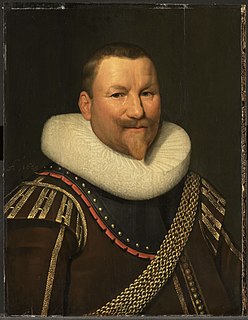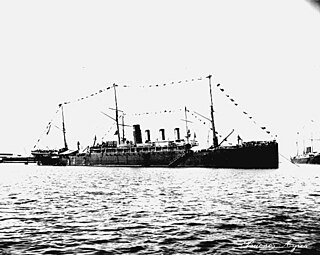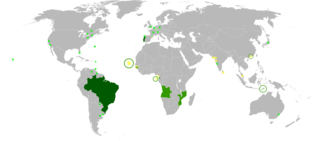
Pieter Pietersen Heyn (Hein) was a Dutch admiral and privateer for the Dutch Republic during the Eighty Years' War between the United Provinces and Spain. Hein was the first and the last to capture a large part of a Spanish "silver fleet" from America.
Admiral is one of the highest ranks in some navies, and in many navies is the highest rank. It is usually abbreviated to "Adm" or "ADM". The rank is generally thought to have originated in Sicily from a conflation of Arabic: أمير البحر, amīr al-baḥr, "commander of the sea", with Latin admirabilis ("admirable") or admiratus ("admired"), although alternative etymologies derive the word directly from Latin, or from the Turkish military and naval rank miralay. The French version – amiral without the additional d – tends to add evidence for the Arab origin.

General admiral was a Danish, Dutch, German, Russian, Portuguese, Spanish and Swedish naval rank. Its historic origin is a title high military or naval dignitaries of early modern Europe sometimes held, for example the (nominal) commander-in-chief of the Dutch Republic's navy.

John Woodward Philip was an officer in the United States Navy during the Civil War and Spanish–American War.

Diego Columbus (1479/1480-1526) was a Portuguese navigator and explorer under the Kings of Castile and Aragón. He served as the 2nd Admiral of the Indies, 2nd Viceroy of the Indies and 4th Governor of the Indies as a vassal to the Kings of Castile and Aragón. He was the elder son of Christopher Columbus and his wife Filipa Moniz Perestrelo.

Don Francisco Serrano Domínguez Cuenca y Pérez de Vargas, 1st Duke of la Torre, Grandee of Spain, Count of San Antonio was a Spanish marshal and statesman. He was Prime Minister of Spain in 1868–69 and regent in 1869–70.

Admiral Segismundo Bermejo y Merelo was a Spanish naval officer who served as chief of staff in the Spanish Navy and Minister of the Navy during the Spanish–American War. He was most notable for his role in dispatching Rear Admiral Pascual Cervera y Topete, in command of a squadron of four cruisers and three destroyers, to Cuba in May 1898. It set up the conditions for the naval Battle of Santiago de Cuba. Bermejo himself was forced to resign as naval minister after the defeat of the Spanish Pacific Squadron at the Battle of Manila Bay by the U.S. Navy, and he died a year later.

The Glorious Revolution took place in Spain in 1868, resulting in the deposition of Queen Isabella II. The success of the revolution marked the beginning of the Sexenio Democrático with the installment of a provisional government.

Furor was a Furor-class destroyer of the Spanish Navy that fought at the Battle of Santiago de Cuba during the Spanish–American War.

Pelayo was a battleship of the Spanish Navy which served in the Spanish fleet from 1888 to 1925. She was the first battleship and the most powerful unit of the Spanish Navy. Despite its modern design for the time, Pelayo and the rest of the Spanish Asia-Pacific Rescue Squadron never engaged in combat during the Spanish–American War. Some historians argue the battleship, along with Armored Cruiser Carlos V, would have changed the course of the war dramatically, leading to a possible Spanish victory, thus consolidating Spain's status as a colonial power.

Emperador Carlos V was an armored cruiser of the Spanish Navy which served in the Spanish fleet from 1898 to 1933.

Buenos Aires was a merchant ship requisitioned for use as a transport by the Spanish Navy in June and July 1898 during the Spanish–American War.

The Almirante Cervera class were three light cruisers built for the Spanish Navy in the 1920s. The ships were built by Sociedad Española de Construcción Naval in Ferrol which had strong British links and were designed by Sir Philip Watts. The design was based on the British Emerald-class cruiser, but had all boilers grouped together reducing the number of funnels to two. The main armament comprised Vickers pattern 6-inch guns with single mountings in "A" and "Y" positions and twin turrets in "B", "Q" and "X" positions. The programme was initially authorised in 1915 but was delayed by World War I with construction of the first ship starting in 1917.

The recapture of Bahia was a Spanish-Portuguese military expedition in 1625 to retake the city of Salvador da Bahia in Brazil from the forces of the Dutch West India Company (WIC).
The Action of 12–17 January 1640 was a naval battle between a Dutch fleet and a combined Spanish-Portuguese fleet during the Eighty Years' War. The battle took place on the Brazilian coast off Pernambuco and was an attempt by a fleet consisting of approximately eighty vessels transporting about 5,000 soldiers under the command of Portuguese Admiral Fernando de Mascarenhas to land reinforcements to bolster the Portuguese militia besieging the city of Recife. On 12 January this fleet was intercepted by a Dutch task force of about forty ships commanded by Willem Loos. The ensuing battle lasted with occasional breaks until the evening of 17 January, when the Spanish and Portuguese fleet retreated and sailed away to the north.

Ramón Acha Caamaño was a brigadier general in the Spanish Army. As Captain in charge of the Spanish Artillery in San Juan, he defended Puerto Rico against U.S. attack during the Spanish–American War.

Carballo is originally a, surname. The surname derived from both a (Galician) and (Portuguese) word meaning Oak, referring to the families settlement's surroundings of forest on mountainous terrain in A Coruña, Galicia, the north western part of Spain. Throughout the years the surname has become more frequent among other countries and the name has had variances in its spelling. It widely became renowned in the early 1600s in the Spanish colonization of the Americas or New Spain and greatly expanded during the 1800s. Spreading from South America, Central America, Mexico and North America, also including the Philippine islands, Cuba and Puerto Rico, territories of Spanish Colonialism or colonial expansion under the Crown of Castile during Spanish holdings in the Age of Discovery.

Admiral Ramón Auńón y Villalón was a Spanish naval officer who served as the Minister of the Navy during the Spanish–American War, replacing Segismundo Bermejo y Merelo. He had joined the Armada at the age of 15 and fought in conflicts in Africa and Cuba, later commanding a battleship and gaining a reputation for being an efficient administrator. Upon becoming Minister of the navy, Auńon was forced to make a decision of whether or not Admiral Pascual Cervera y Topete's squadron in Santiago de Cuba should sortie or not. He ultimately decided in favor, resulting in the Battle of Santiago de Cuba. Afterwards, he would serve as a member of the Congress of Deputies and as civil governor of the Province of Barcelona.




















